
Supple Strength: Flexibility for Optimal Sport Health
Flexibility is often undervalued in the realm of sports, yet it is a cornerstone of optimal health and athletic performance. This article explores the multifaceted benefits of flexibility for sport health, emphasizing how incorporating flexibility training into sports routines can enhance overall well-being and elevate athletic prowess.
Understanding the Significance of Flexibility in Sports
Flexibility is the ability of muscles and joints to move through a full range of motion. In sports, this translates to improved performance, injury prevention, and enhanced functional movement. Athletes benefit from understanding the crucial role flexibility plays in achieving peak physical condition.
Enhanced Range of Motion: A Key Benefit of Flexibility
One of the primary benefits of flexibility is the expanded range of motion it affords. Athletes with increased flexibility can execute movements with greater amplitude, translating to improved agility, reduced stiffness, and an enhanced ability to perform various athletic maneuvers.
Injury Prevention Through Flexibility Training
Flexibility is a potent tool in the prevention of injuries. A body with good flexibility is less prone to strains, sprains, and muscle imbalances. Through targeted stretching exercises, athletes can address muscle tightness, reduce the risk of overuse injuries, and create a more resilient musculoskeletal system.
Muscle Imbalance Correction: Achieving Symmetry in Strength
In many sports, certain muscle groups are emphasized more than others, leading to muscle imbalances. Flexibility training helps correct these imbalances by targeting underused muscle groups. Achieving symmetry in strength reduces the risk of overcompensation injuries and contributes to a more harmonious and efficient body.
Flexibility’s Contribution to Muscular Power
Contrary to a common misconception, flexibility and muscular power are not mutually exclusive. In fact, flexibility can enhance muscular power. A muscle that can move through its full range of motion can generate more force, resulting in powerful and efficient athletic movements.
Joint Health and Flexibility: A Symbiotic Relationship
Healthy joints are crucial for sports performance, and flexibility plays a pivotal role in maintaining joint health. Properly stretched muscles reduce the stress on joints during movements, contributing to joint longevity and reducing the risk of conditions such as arthritis.
Flexibility and Recovery: Alleviating Muscle Soreness
Incorporating flexibility exercises into post-workout routines aids in muscle recovery. Stretching helps alleviate muscle soreness by promoting blood flow, reducing muscle tension, and preventing the buildup of lactic acid. This promotes a quicker recovery turnaround for athletes.
Specificity in Flexibility Training for Different Sports
Flexibility needs vary across sports. Tailoring flexibility training to the specific demands of a sport is crucial. For example, a gymnast may focus on different muscle groups than a soccer player. Specificity ensures that flexibility training directly contributes to the requirements of an athlete’s chosen discipline.
Flexibility and Mental Well-Being: The Mind-Body Connection
The mind-body connection is a powerful aspect of flexibility training. Incorporating stretching and flexibility exercises into a routine promotes mindfulness and relaxation. The meditative nature of these activities contributes to mental well-being, reducing stress and enhancing an athlete’s overall resilience.
Holistic Athletic Performance: Integrating Flexibility into Training
In conclusion, flexibility is not just a component of athletic training but a foundation for holistic athletic performance. Athletes who integrate flexibility into their training routines benefit from improved range of motion, injury prevention, and enhanced recovery. To explore more about Flexibility for Sport Health, click here for valuable insights and resources to elevate your athletic prowess through flexibility training.














